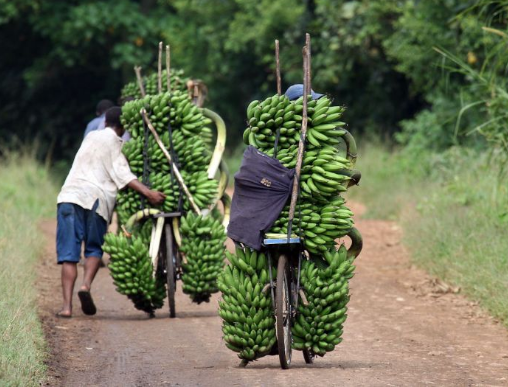One Kisii County farmer has abandoned risky night guarding of bananas after learning that simple paint labeling can significantly reduce mass stealing of the produce.
The simple method has saved him from night guarding against large-scale stealing, which was many a time risky as thieves were armed with machetes and other crude weapons.
Michael Ayako adopted ‘Baba Yao or ‘BY’ as his trade name and he paints either of the two marks on the stalk of the bananas while the fruit is attacked to the parent plant.
Although this has not tamed one or bunches stealing for domestic use, harvesting of more than five mature bananas at once from his 36-crop plantation has significantly dropped since last year.
The letters are written in white paint right at the end of the topmost bunch. A few other fruits are randomly marked with the paint for identification from a far.
“The people know ‘Baba Yao’ as my brand name. Anyone who will be found with bananas bearing this name will have to explain how they got them. The method has actually worked and the villagers and buyers now easily identify my produce, something that thieves fear because they can be spotted,” the farmer says.
Baba Yao is a common nickname in Kenya first used by Kabete Member of Parliament Ferdinard Waititu to refer to himself as the mightiest defender of his constituents.
He picked the nickname in 2015 because of its popularity.
On wholesale, Ayako sells the bananas at prices ranging from Sh400 to Sh700 depending on the size. But the thieves can sell the same at Sh400 or less.
He harvests between 10 and 15 bananas a month, although at times this varies depending on the amount of rain during flowering and maturation.
“My bananas range from 50kg to 80kg. I wait for more than six months before harvesting. Stealing took away my toil, my wait and my hopes of commercialising the crop. When I found there are no bananas in the shamba the following day,” he says.
Plantain is a major food in Kenya, with urban consumers paying almost twice the same amount it is sold in the production areas.
Nyanza, Coast regions’ Taita-Taveta, and central are the common commercial banana producing areas.
Whilst Taita-Taveta County serves towns such as Mombasa, Kilifi and Diani, central and Kisii regions supply their produce to Nairobi, Nakuru, Kisumu, and Mombasa at times.
One time when Ayieko visited Nairobi’s Mkulima market, he realised the banana sellers encrypted some unique letters or arrows on the stalks to indicate ownership.
Write comment (0 Comments)
















